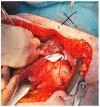Current Therapeutic Approaches in Cervical Cancer Based on the Stage of the Disease: Is There Room for Improvement?
- PMID: 37512041
- PMCID: PMC10384945
- DOI: 10.3390/medicina59071229
Current Therapeutic Approaches in Cervical Cancer Based on the Stage of the Disease: Is There Room for Improvement?
Abstract
Cervical cancer continues to be among the most common malignancies in women, and in recent decades, important measures have been taken to reduce its incidence. The first and most important steps to achieve this goal are oriented toward prevention through screening programs and vaccination, mainly against oncogenic human papillomavirus (HPV) strains 16 and 18. The therapeutic approach is based on the diagnosis and treatment guidelines for cervical cancer, which establish for each stage (FIGO, TNM) specific conduct. These guidelines summarize quite precisely the elements of therapeutic practice, but, in some places, they leave optional variants based on which nuanced approaches could be established. Adherence to these guidelines, which include the performing of minor or major surgery, with or without chemotherapy and radiation therapy, combined with advanced imaging investigations, has been able to lead to a substantial increase in survival. The purpose of this literature review is to discuss the diagnosis and treatment options in cervical cancer depending on the histological type, FIGO staging, and patient performance index, taking into account the hospital resources available in middle-income countries (percentage of gross domestic product allocated to health services around 5.5%, in the case of Romania).
Keywords: FIGO; cervical cancer; hysterectomy; lymph nodes; oncology; radiotherapy; surgery.
Conflict of interest statement
The authors declare no conflict of interest.
Figures




References
-
- Roura E., Castellsagué X., Pawlita M., Travier N., Waterboer T., Margall N., Bosch F.X., de Sanjosé S., Dillner J., Gram I.T., et al. Smoking as a major risk factor for cervical cancer and pre-cancer: Results from the EPIC cohort. Int. J. Cancer. 2014;135:453–466. doi: 10.1002/ijc.28666. - DOI - PubMed

